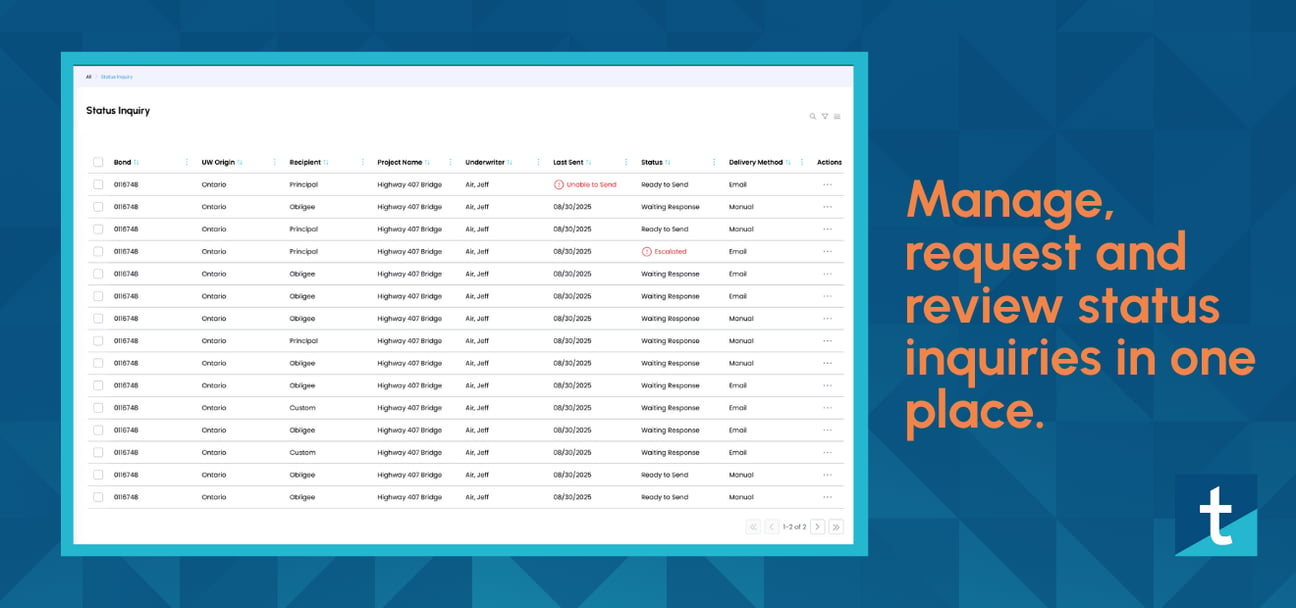
In the Surety industry, issuing a contract bond is just the first step. From there, carriers play an active role in helping projects move forward smoothly, managing funds, monitoring progress, and supporting stakeholders long before a shovel hits the ground.
Once construction has begun, one of the most effective tools for staying on track is the status inquiry, sometimes called progress report. These regular updates provide early visibility into how projects are unfolding, allowing carriers to address issues promptly, maintain budget alignment, and ensure timely completion. They also contain the information that enables carriers to update their work-in-progress (WIP) reports.
When carriers receive consistent, detailed responses to status inquiries, they gain the insight needed to guide projects with confidence and efficiency.
The Role of Status Inquiries in Risk Mitigation
The response to a status inquiry provides a structured snapshot of a bonded project’s health. It turns a carrier from a passive guarantor to an active, informed risk manager. Key information gleaned from these reports includes:
- Budget and Financial Status: Is the project on budget? Are there cost overruns? How does the completed work-to-date compare to the billings? This helps identify potential financial distress long before a contractor runs out of funds.
- Timeline and Schedule Adherence: Is the project on schedule? What are the causes and lengths of any delays? Early identification allows carriers to understand if delays are manageable or indicative of a more serious problem.
- Changes and Challenges: Have there been significant change orders? Are there unresolved disputes with the client or subcontractors? This reveals hidden risks that may not be apparent from a high-level view.
- Project Percentage Complete: This crucial metric helps carriers verify whether a project's financial trajectory aligns with its physical progress.
Without this data, carriers are left responsible for a project’s outcome without visibility into its journey, unable to intervene proactively to prevent a claim.
The Problem With Status Inquiries
Everybody likes receiving responses to status inquiries, but nobody likes managing them. Despite their importance, the process of making status inquiries, receiving the information and using it to update a WIP is often a challenge for carriers. Traditionally, the process is manual and asks contractors to do considerable form filling, whether they’re submitting reports directly or through an obligee. This leads to a low return rate. When a report does reach a carrier, its data has to be manually reentered, typically using multiple workflows. Among the main frustrations are:
- Labor-Intensive Tracking: Carrier teams rely on spreadsheets and calendar reminders to track which bonds require progress updates and when.
- Cumbersome Requests: Generating, sending, and following up on status inquiry requests via email, and even by phone, is slow.
- Low Response Rates: Perhaps the biggest hurdle: after all that effort, many people simply didn’t return their forms. The manual process of printing, scanning, and sending is a significant barrier for respondents, leaving carriers in the dark on the very projects they need to monitor most.
- Data Entry Silos: When reports are returned, data often has to be manually entered into systems, creating opportunities for error and making it difficult to get a consolidated view of risk.
Improving the Status of Status Inquiries: Tinubu’s Approach
Tinubu has developed a new feature that will transform the issuance and management of status inquiries from a manual process into an automated, efficient workflow that addresses core carrier challenges.
Phase one of the new Tinubu tool—which has just been released to one of our clients in a beta version and will soon be fully launched—will enable carriers to take a “set it and forget it” approach to status inquiries. When a bond is created, the carrier can establish a template and custom schedule for status inquiries. For example, they may want a report every quarter. Once it’s set up, the system will automatically generate an inquiry when needed, ready to be printed and downloaded so it can be physically mailed and/or sent electronically. When the report is returned, carriers can use it to update their WIPs in the same part of the Tinubu platform. All data is held and can be used in the same workspace, meaning there is no longer a need to use multiple workflows for the status inquiry and WIP process, leaving more time for analysis.
Phase two of the new tool will further automate the process of converting status inquiries to WIPs. It will also remove a traditional barrier for inquiry requests: the need for printing, scanning, mailing or emailing. The new system will automatically email a PDF to respondents, which they can fill in and return on their phones. This convenience will make it far easier and more appealing for contractors to respond to carrier status inquiries.
The Bottom Line for Carriers
The evolution of the status inquiry and updating of WIPs from a manual chore to an automated insight engine will represent a meaningful advance for Surety carriers. It will make it easier for them to perform proactive, not reactive risk and bond management. Carriers will be able to identify issues earlier and work with contractors on solutions before they escalate into claims. Simplifying the process for everybody will lead to more collaborative partnerships and more effective risk management.







